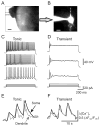Inflammation alters trafficking of extrasynaptic AMPA receptors in tonically firing lamina II neurons of the rat spinal dorsal horn
- PMID: 21282008
- PMCID: PMC3079375
- DOI: 10.1016/j.pain.2011.01.016
Inflammation alters trafficking of extrasynaptic AMPA receptors in tonically firing lamina II neurons of the rat spinal dorsal horn
Abstract
Peripheral inflammation alters AMPA receptor (AMPAR) subunit trafficking and increases AMPAR Ca(2+) permeability at synapses of spinal dorsal horn neurons. However, it is unclear whether AMPAR trafficking at extrasynaptic sites of these neurons also changes under persistent inflammatory pain conditions. Using patch-clamp recording combined with Ca(2+) imaging and cobalt staining, we found that, under normal conditions, an extrasynaptic pool of AMPARs in rat substantia gelatinosa (SG) neurons of spinal dorsal horn predominantly consists of GluR2-containing Ca(2+)-impermeable receptors. Maintenance of complete Freund's adjuvant (CFA)-induced inflammation was associated with a marked enhancement of AMPA-induced currents and [Ca(2+)](i) transients in SG neurons, while, as we previously showed, the amplitude of synaptically evoked AMPAR-mediated currents was not changed 24 h after CFA. These findings indicate that extrasynaptic AMPARs are upregulated and their Ca(2+) permeability increases dramatically. This increase occurred in SG neurons characterized by intrinsic tonic firing properties, but not in those exhibited strong adaptation. This increase was also accompanied by an inward rectification of AMPA-induced currents and enhancement of sensitivity to a highly selective Ca(2+)-permeable AMPAR blocker, IEM-1460. Electron microcopy and biochemical assays additionally showed an increase in the amount of GluR1 at extrasynaptic membranes in dorsal horn neurons 24h post-CFA. Taken together, our findings indicate that CFA-induced inflammation increases functional expression and proportion of extrasynaptic GluR1-containing Ca(2+)-permeable AMPARs in tonically firing excitatory dorsal horn neurons, suggesting that the altered extrasynaptic AMPAR trafficking might participate in the maintenance of persistent inflammatory pain.
Copyright © 2011 International Association for the Study of Pain. All rights reserved.
Conflict of interest statement
The authors declare no conflict of interests.
Figures







Similar articles
-
Development of inflammation-induced hyperalgesia and allodynia is associated with the upregulation of extrasynaptic AMPA receptors in tonically firing lamina II dorsal horn neurons.Front Physiol. 2012 Oct 2;3:391. doi: 10.3389/fphys.2012.00391. eCollection 2012. Front Physiol. 2012. PMID: 23060815 Free PMC article.
-
PKCα is required for inflammation-induced trafficking of extrasynaptic AMPA receptors in tonically firing lamina II dorsal horn neurons during the maintenance of persistent inflammatory pain.J Pain. 2013 Feb;14(2):182-92. doi: 10.1016/j.jpain.2012.10.015. J Pain. 2013. PMID: 23374940 Free PMC article.
-
Opioid receptors inhibit the spinal AMPA receptor Ca2+ permeability that mediates latent pain sensitization.Exp Neurol. 2019 Apr;314:58-66. doi: 10.1016/j.expneurol.2019.01.003. Epub 2019 Jan 17. Exp Neurol. 2019. PMID: 30660616 Free PMC article.
-
Extrasynaptic AMPA receptors in the dorsal horn: evidence and functional significance.Brain Res Bull. 2013 Apr;93:47-56. doi: 10.1016/j.brainresbull.2012.11.004. Epub 2012 Nov 26. Brain Res Bull. 2013. PMID: 23194665 Review.
-
The AMPAR subunit GluR2: still front and center-stage.Brain Res. 2000 Dec 15;886(1-2):190-207. doi: 10.1016/s0006-8993(00)02951-6. Brain Res. 2000. PMID: 11119696 Review.
Cited by
-
The search for novel analgesics: targets and mechanisms.F1000Prime Rep. 2015 May 26;7:56. doi: 10.12703/P7-56. eCollection 2015. F1000Prime Rep. 2015. PMID: 26097729 Free PMC article. Review.
-
Loss of ICA69 potentiates long-lasting hyperalgesia after subcutaneous formalin injection into the mouse hindpaw.Neurochem Res. 2015 Mar;40(3):579-90. doi: 10.1007/s11064-014-1503-z. Epub 2014 Dec 30. Neurochem Res. 2015. PMID: 25547463
-
Development of inflammation-induced hyperalgesia and allodynia is associated with the upregulation of extrasynaptic AMPA receptors in tonically firing lamina II dorsal horn neurons.Front Physiol. 2012 Oct 2;3:391. doi: 10.3389/fphys.2012.00391. eCollection 2012. Front Physiol. 2012. PMID: 23060815 Free PMC article.
-
Ceftriaxone and clavulanic acid induce antiallodynia and anti-inflammatory effects in rats using the carrageenan model.J Pain Res. 2018 May 21;11:977-985. doi: 10.2147/JPR.S154661. eCollection 2018. J Pain Res. 2018. PMID: 29861639 Free PMC article.
-
AKAP150 and its Palmitoylation Contributed to Pain Hypersensitivity Via Facilitating Synaptic Incorporation of GluA1-Containing AMPA Receptor in Spinal Dorsal Horn.Mol Neurobiol. 2021 Dec;58(12):6505-6519. doi: 10.1007/s12035-021-02570-z. Epub 2021 Sep 24. Mol Neurobiol. 2021. PMID: 34559357
References
-
- Albuquerque C, Lee CJ, Jackson AC, MacDermott AB. Subpopulations of GABAergic and non-GABAergic rat dorsal horn neurons express Ca2+-permeable AMPA receptors. Eur J Neurosci. 1999;11:2758–2766. - PubMed
-
- Allan SM, Rothwell NJ. Cytokines and acute neurodegeneration. Nat Rev Neurosci. 2001;2:734–744. - PubMed
-
- Atianjoh FE, Yaster M, Zhao X, Takamiya K, Xia J, Gauda EB, Huganir RL, Tao YX. Spinal cord protein interacting with C kinase 1 is required for the maintenance of complete Freund’s adjuvant-induced inflammatory pain but not for incision-induced post-operative pain. Pain. 2010;151:226–234. - PMC - PubMed
-
- Balasubramanyan S, Stemkowski PL, Stebbing MJ, Smith PA. Sciatic chronic constriction injury produces cell-type-specific changes in the electrophysiological properties of rat substantia gelatinosa neurons. J Neurophysiol. 2006;96:579–590. - PubMed
Publication types
MeSH terms
Substances
Grants and funding
LinkOut - more resources
Full Text Sources
Miscellaneous

